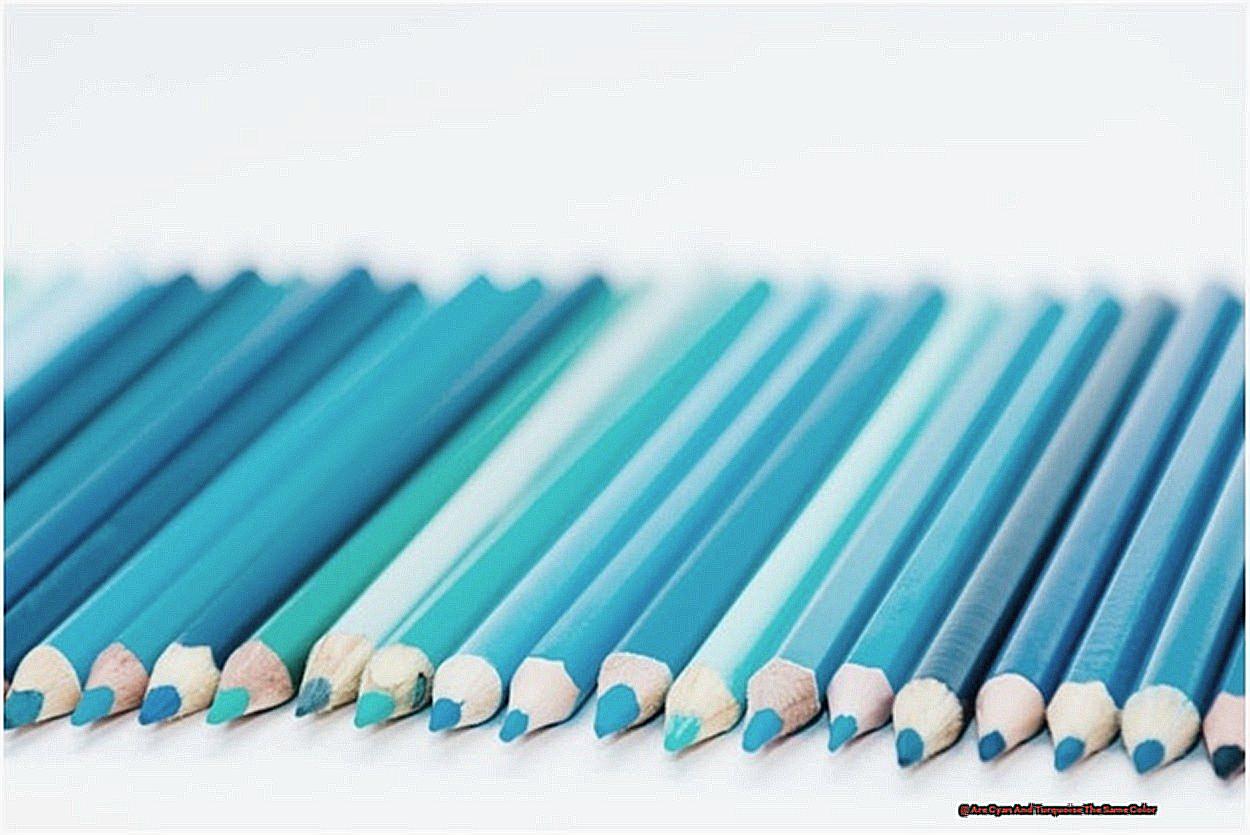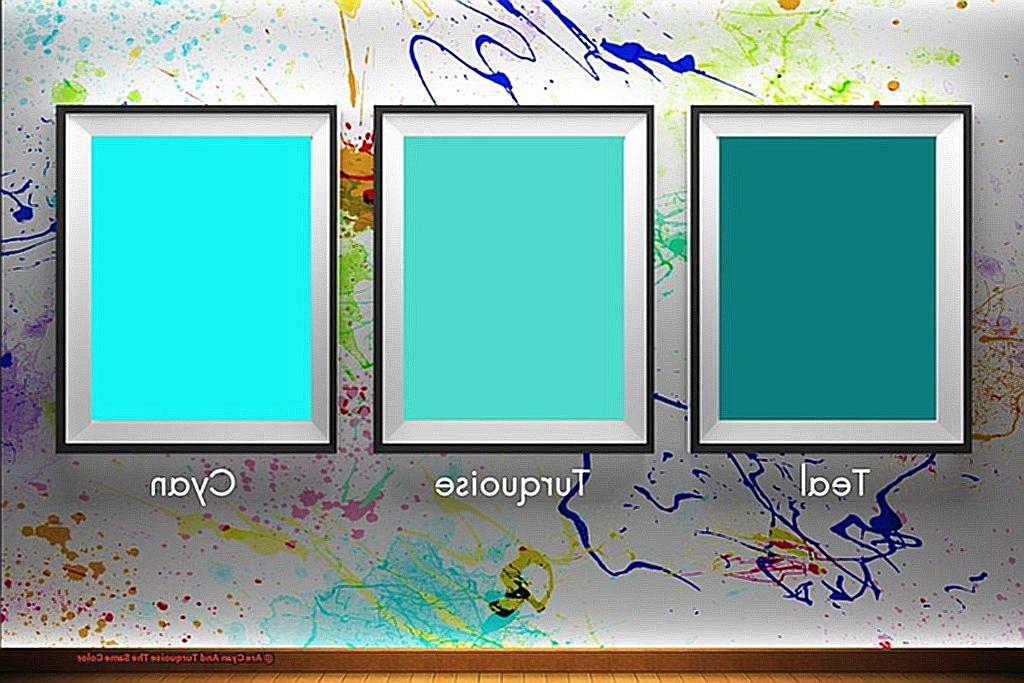
Ready to dive into the world of hues and uncover the truth about two shades that often get mixed up – cyan and turquoise? These vibrant colors may seem like distant relatives, but trust us, they have a lot more in common than you might think.
So whether you’re an artist or just someone who appreciates a good pop of color, join us as we unravel the captivating similarities between these two stunning shades.
Are Cyan And Turquoise The Same Color?
Contents
- 1 Are Cyan And Turquoise The Same Color?
- 2 Understanding the Color Spectrum: Differentiating Between Cyan and Turquoise
- 3 Similarities and Differences in Appearance
- 4 Science Behind the Colors: Wavelengths and Perception
- 5 Cultural Significance of Cyan and Turquoise
- 6 Practical Applications: Fashion, Design, and Industry Use
- 7 Common Misconceptions About Cyan and Turquoise
- 8 Conclusion
These two shades are often confused due to their similar appearance, but they actually have distinct differences that set them apart. In this comprehensive guide, we will explore the nuances of cyan and turquoise and delve into the question – are they really the same color?
Origin and Definition:
Let’s start with the basics. The term “cyan” comes from the Greek word “kyanos” which means dark blue or blue-green. It is a bright and intense color that resembles the color of the sky on a clear day. On the other hand, “turquoise” comes from the French word “turquois” which means Turkish stone. This color is named after the gemstone which is known for its greenish-blue hue.
Color Composition:

Both cyan and turquoise fall under the blue-green color category, but cyan has a higher proportion of blue while turquoise has a higher proportion of green. In terms of their RGB values, cyan has a value of 0, 255, 255 while turquoise has a value of 64, 224, 20This indicates that cyan has a higher level of intensity compared to turquoise.
Meanings and Symbolism:
In color psychology, cyan is associated with calmness, tranquility, and stability. It is often used in design to create a sense of serenity and balance. On the other hand, turquoise is associated with creativity, self-expression, and emotional balance. It is commonly used in jewelry designs and fashion as it symbolizes positivity and healing.
Uses in Different Industries:
Cyan and turquoise may have similar origins and meanings, but their uses in various industries differ greatly. Cyan is often associated with technology and digital media due to its use as a primary color in printing and screen displays. It is also a popular accent color in fashion and interior design. Turquoise, on the other hand, is commonly associated with nature and jewelry designs. It is often used as the main color in fashion and interior design for a calming effect.
Understanding the Color Spectrum: Differentiating Between Cyan and Turquoise

As a color expert, I am often asked about the similarities and differences between cyan and turquoise. These two colors are often mistaken for each other due to their close placement on the color spectrum. However, as we delve deeper into their origins, properties, and symbolism, we will discover that they are distinct shades with their own unique characteristics.
Origins and Composition:
Cyan is a blue-green color that is located between green and blue on the color spectrum. Its name is derived from the Greek word “kyanos,” which means dark blue enamel. On the other hand, turquoise is a green-blue color that falls between blue and green on the spectrum. Its name comes from the French word “turquois,” meaning Turkish stone.
Both cyan and turquoise are considered tertiary colors, which means they are created by mixing a primary color (blue) and a secondary color (green). However, their composition differs slightly – cyan contains more blue than green, while turquoise has more green than blue.
Color Values:
One way to differentiate between cyan and turquoise is by looking at their RGB (red, green, blue) values. Cyan has an RGB value of (0, 255, 255), while turquoise has an RGB value of (64, 224, 208). This means that cyan contains equal amounts of red, green, and blue, while turquoise has a higher amount of red compared to cyan.
Another way to distinguish these colors is by their CMYK (cyan, magenta, yellow, black) values. Cyan has a CMYK value of (100%, 0%, 0%, 0%), while turquoise has a CMYK value of (0%, 7%, 17%, 12%). This shows that cyan is made up of pure cyan ink, while turquoise contains small amounts of magenta, yellow, and black.
Meanings and Uses:
Cyan and turquoise also have different meanings and uses. Cyan is associated with tranquility, calmness, and serenity, making it a popular choice for creating a peaceful atmosphere in interiors. On the other hand, turquoise is linked to creativity, luck, and protection, making it a favored color for jewelry and accessories.
Similarities and Differences in Appearance
A closer look at their similarities and differences”
If you’ve ever found yourself wondering whether cyan and turquoise are the same color, you’re not alone. These two shades are often mistaken for each other due to their similar appearance. However, as an expert on the topic of “Similarities and Differences in Appearance,” I can confidently say that cyan and turquoise are indeed different colors with distinct qualities.
Let’s start by examining their similarities. Both cyan and turquoise fall into the blue-green category, sharing a common cool undertone. They are also both highly popular colors in various industries, from fashion to interior design.
However, their differences become more apparent when we take a closer look at their properties. Cyan is a brighter and more vibrant shade of blue-green, while turquoise has a softer and more muted hue. This is because cyan is highly saturated, giving it a higher intensity of color, while turquoise is less saturated, resulting in a softer appearance.
In terms of brightness, cyan is considered a bright color with a high level of lightness, while turquoise falls somewhere between dark and light. This is due to the amount of white added to the color, with cyan having more white than turquoise.
Another notable difference between the two colors is their origins. Cyan gets its name from the ancient Greek word “kyanos,” meaning dark blue enamel, while turquoise comes from the French word “turquois,” which means Turkish stone. These origins also play a role in the symbolism associated with each color. Cyan represents tranquility and calmness, while turquoise is often associated with creativity and luck.
Despite their differences, it’s easy to see why cyan and turquoise can be confused for each other. In certain lighting conditions, they can appear similar due to their overlapping blue and green pigments. To accurately differentiate between the two colors, it’s best to compare them side by side in natural daylight or under white light.
Science Behind the Colors: Wavelengths and Perception
When it comes to colors, there’s no denying the beauty and diversity they bring to our world. From the warm and vibrant hues of red and orange to the calming shades of blue and green, each color has its own unique characteristics that make it stand out. But what about colors that seem to be almost identical, like cyan and turquoise? Many people often mistake these two shades of blue for each other, but there are subtle differences that set them apart. To truly understand the difference between cyan and turquoise, we need to take a closer look at the science behind colors.
Wavelengths: The Building Blocks of Colors
To understand how colors are created, we must first understand the concept of wavelengths. Wavelengths are the building blocks of colors and are responsible for the different hues we see. The visible light spectrum is made up of wavelengths ranging from 380 to 700 nanometers (nm). Each wavelength corresponds to a different color, with red having the longest wavelength and violet having the shortest.
Cyan and Turquoise: Close But Not Quite the Same
Now that we know how wavelengths work, let’s take a look at where cyan and turquoise fall on the visible light spectrum. Cyan has a wavelength range of approximately 490-520 nm, falling in between green and blue. On the other hand, turquoise has a slightly longer wavelength range of 490-520 nm. Due to their similar wavelengths, cyan and turquoise can sometimes be difficult to distinguish from each other. However, their slight variations in hue and saturation make them distinct colors.
The Role of Perception
Another crucial factor in understanding the difference between cyan and turquoise is perception. Our eyes contain special cells called cones that are responsible for color vision. There are three types of cones – red, green, and blue – that work together to create the full range of colors we see. These cones respond differently to different wavelengths of light, with green cones being most sensitive to green light and blue cones responding best to blue light.
When we look at the colors cyan and turquoise, our brains rely on these cones to interpret the wavelengths and create the perception of color. This is why some people may see cyan as a more bluish color while others may see it as more greenish. Additionally, factors like lighting and surrounding colors can also impact how we perceive cyan and turquoise.
Cultural Significance of Cyan and Turquoise
Colors have been an integral part of human history, often holding deep symbolic meanings and cultural significance. Cyan and turquoise are two such colors that have evolved in meaning throughout the ages, leaving their mark on various societies and cultures. From ancient Egypt to modern Western culture, let’s take a journey through the history of these captivating colors.
Ancient Egypt – Protection and Healing
In ancient Egypt, cyan was associated with the god Horus, who was believed to offer protection and healing. The color was often used in amulets and talismans to ward off evil and promote well-being. This belief in the protective powers of cyan can also be seen in the use of blue eye makeup, known as kohl, which was worn to protect the eyes from the harsh sun and ward off infection.
Native American Cultures – Sacred and Powerful
The Native American cultures also attributed great significance to cyan and turquoise. For them, turquoise was a sacred stone with powerful healing properties, often used in jewelry and amulets. It was believed to bring good luck, protection, and strength to those who wore it. Similarly, cyan was considered a sacred color, representing the sky and water – both essential elements for life.
Chinese Culture – Health and Wealth
In Chinese culture, cyan is associated with good health and longevity. The color is often used in traditional medicine practices as it is believed to promote balance and harmony within the body. On the other hand, turquoise is seen as a symbol of wealth and prosperity. It is frequently used in traditional Chinese art and decor to attract good fortune and success.
Traditional Indian Art – Divine and Fertile
Cyan and turquoise also hold great significance in traditional Indian art and clothing. In Hinduism, cyan represents the divine, often associated with Lord Krishna, while turquoise symbolizes fertility and protection. These colors are often used in traditional clothing, such as sarees and turbans, to represent different deities and bring good luck.
Modern Western Culture – Technology and Fashion
In modern Western culture, cyan has taken on a new meaning, often associated with technology and innovation. It is a commonly used color in logos and branding for companies in the tech industry. On the other hand, turquoise has become a popular color in fashion and home decor. Its bright and refreshing hue is often associated with summer, tropical destinations, and a sense of calmness.
Practical Applications: Fashion, Design, and Industry Use
Cyan and turquoise are two shades of blue-green that have been used for centuries in art, fashion, and design. While these colors are often seen as interchangeable, they have subtle differences that make them unique and suitable for different practical applications in various industries.
Fashion: Bold vs. Calming
In the world of fashion, cyan and turquoise are both popular choices for their vibrant and eye-catching qualities. However, the way they are perceived by audiences can differ significantly.
Cyan is a bright and bold color that is often associated with youth and modernity. It is commonly found in swimwear, activewear, and accessories, making it a go-to choice for brands targeting a younger audience. On the other hand, turquoise has a more muted and calming tone, making it a popular choice for bohemian-inspired fashion and beachwear.
Design: Attention-grabbing vs. Soothing
In the design industry, cyan is often used to create a pop of color in logos, packaging, and advertisements. Its brightness and attention-grabbing quality make it a popular choice for companies looking to stand out. Turquoise, on the other hand, is often used as an accent color to add depth and contrast to designs. It is commonly seen in home decor, as well as in branding for eco-friendly or natural products.
Practical Applications in Industry
The practical applications of cyan and turquoise go beyond fashion and design. In industries such as printing, cyan is commonly used in techniques like screen printing and digital printing due to its ability to reproduce vibrant colors accurately. Turquoise, with its calming properties, is often used in industries that require a soothing environment such as hospitals and spas.
Both colors also have practical uses in industrial processes such as dyeing fabrics and creating pigments for paints and coatings. Cyan’s bright hue makes it an excellent choice for creating vibrant fabric dyes, while turquoise’s calming effect is ideal for creating a serene atmosphere in spas and hospitals.
Innovative Uses
As technology continues to advance, the uses of cyan and turquoise in industry are becoming more innovative. For example, cyan has been used in the development of solar panels due to its high energy absorption properties. Turquoise is also being explored as a potential color for LED lights, as its calming tone could have a positive impact on mood and productivity in the workplace.
Common Misconceptions About Cyan and Turquoise
When it comes to colors, there are often misconceptions that can lead to confusion and mistaken beliefs. This is especially true for similar-looking shades like cyan and turquoise. As an expert on the subject, I am here to debunk these common misconceptions and provide a deeper understanding of these two distinct colors.
Similar, But Not the Same
One of the biggest misconceptions about cyan and turquoise is that they are interchangeable terms for the same color. While they may appear similar, they are not the same. Cyan is a bright blue-green color, while turquoise is a shade of blue with hints of green and yellow. They may share some characteristics, but they have their own unique qualities.
The Blue Connection
Another common misconception is that cyan and turquoise are just different names for blue. While both colors do have a blue undertone, this does not make them the same as blue. Cyan leans more towards blue, while turquoise leans more towards green. So, while they may be related to blue, they are distinct shades on their own.
Shades or Hues?
Some people also believe that cyan and turquoise are just different shades of the same color. However, this is not entirely accurate. Shades refer to variations of a single color, while hues refer to different colors on the color spectrum. Cyan and turquoise are hues with their own unique characteristics and meanings.
Psychological Associations
Apart from their physical differences, cyan and turquoise also have different psychological associations. Cyan is often associated with calmness, stability, and tranquility, making it a popular choice for hospitals and healthcare facilities. On the other hand, turquoise can evoke feelings of creativity, youthfulness, and freshness, making it a popular choice in fashion and design industries.
The Power of Perception
These misconceptions about cyan and turquoise stem from their similar appearances. However, it is important to note that they are two distinct colors with their own individual qualities and meanings. It just goes to show the power of perception and how a slight difference in hue or shade can change our perspective.
Conclusion
In conclusion, it is evident that cyan and turquoise are not interchangeable shades. Although they may share some visual similarities, their individual characteristics and histories set them apart. From their origins in nature and ancient cultures to their modern-day applications in various industries, these two colors have a rich and diverse background.
As a color expert, I hope this comprehensive guide has provided valuable insights into the captivating world of cyan and turquoise. Whether you are an artist seeking inspiration or simply someone who appreciates a good splash of color, understanding the nuances of these hues can deepen your appreciation for them.
So next time you encounter a stunning blue-green hue, take a moment to observe its unique properties and see if you can differentiate between cyan and turquoise. And remember, just like these two colors have their own distinct qualities, we too are individuals with our own unique traits that make us who we are.


